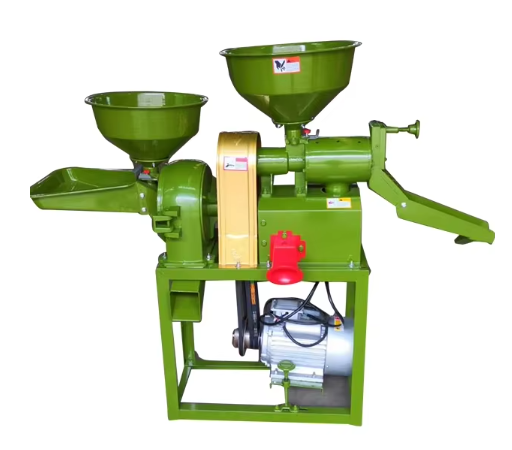Წინასწარი გაწმენდა და ტყავის მოცილება: ეფექტურობის საფუძველი
Უწმინდურობის მოცილება ოპტიმალური ჭრისთვის
Ჩვენი მნიშვნელობის შედარება ტრადიციულ მოდელებთან გაკეთებული წინაპარქინგის პროცესით, რომელიც ძირითადი როლი ასახავს გადასახადების მოკლე მასალების, როგორიცაა ქვაბი, пыль და სხვა გადასახადების წაშლით, რათა მიიღოს მაღალი ხარისხის რისის გადასამუშავებლად. გარდამდინარე მასალების წაშლა იქნება გარკვეული მილინგის ეფექტიურობის მაქსიმიზაციაში და მანქანების აბრასის და გადახარვის მინიმიზაციაში, რაც მიყვანს მაღალი ხარისხის რისამდე. ჩვეულებრივი წინაპარქინგის პროცესები მოიცავს ფილტრაციას, სადაც ფილტრები გამოფილტრებს უფრო დიდი ნაწილებს, და ჰაერის დაბრუნებას, რომელიც გამოიყენებს ვენტილატორებს უფრო მიმართული ნაწილების წაშლისთვის მიმართული ნაწილებისგან. წინაპარქინგის პროცესი მაღალი ხარისხის მილინგის პროცესის ეფექტიურობის გაუმჯობესებაში მოიხსენიება ინდუსტრიულ შესაბამის შესახებ, რადგან ის მინიმიზებს მანქანების ბლოკირებას, რეduce-ს საწინააღმდეგო გადახარვას და მილინგის მანქანების მუშაობის საშუალებას და ცხოვრების განზრავს.
Საწინააღმდეგო ძალაზე დაფუძნული დეჰუსკირების მექანიზმები
Ბარათის გამოკლება წვევის მეთოდით ძირითადია ბარათის ღირებული ნაწილის გამოყოფისთვის, რომელიც არის გარჩევის განსაზღვრული ეტაპი. ეს პროცესები განახლებიან, რომ საწვავები გადახვევა ერთმანეთს ან განახლებულ ზედაპირს, რათა განაყოფონ ქურკი რისიდან. სწორი წვევის მოსახერხებლად ძველია, რათა არ იქნა მეტი შუქი საწვავებზე და აღიარებული რისის ხარისხი და გამოდის მაქსიმალური რაოდენობით. გამოყენებულია, რომ წვევის მეთოდები უფრო ეფექტიურია სხვა ბარათის გამოკლების მეთოდებზე, თუ ისინი სწორად დარგულია, რაც ამაღლებს გარჩევის გამოდის და რისის ხარისხს. ექსპერტები აcentრებენ, რომ სწორი წვევის მარტივი პოვნა განსაზღვრავს მთლიანი საწვავები, ცოტა გადაჭრილი საწვავები და მეტი გამოდის.
Მეტი ინფორმაცია საწინააღმდეგო ძალაზე დაფუძნული დეჰუსკირების მექანიზმებზე, იხილეთ დეტალური გვერდი Rice Rubber Roller .
Ყანახის განახლება და თეთრება: ძირითადი მუშაობის ეტაპები
Გრავიტაციული მეთოდები სანანძრის განახლებისთვის
Წონის მითითებითი განრიცხვის მეთოდები რისის მილინგში ძალიან მნიშვნელოვანი არის პადის განრიცხვისთვის სხვა აბجექტებისგან წონის სახეობის მიხედვით. ეს процედურები ხშირად მოითხოვენ სპეციალურ მაशინებს, მაგალითად გრავიტაციულ სისტემებს ზრახების განრიცხვისთვის. გრავიტაციული სისტემები მუშაობენ და განრიცხული რისის ჩистობა აღმატებს, რისის მილინგის ხარისხს აღმატებს. ინდუსტრიის წყაროები მიუთითებენ, რომ გრავიტაციული მეთოდების ეფექტივობა 90%-ზე მეტია სხვა განრიცხვის ტიპების შედარებით, რისის ჩистობასა და შემოსავალს მნიშვნელოვანად აღმატებს.
Აბრაზიული წინააღმდეგ ფრიქციული თეთრების მეთოდები
Რისი გვერდების შემოწმებამდე, რისი პროცესირების გვერდების ფაზაში, არსებობს განსხვავება აბრაზიულ და ტრიქოტაჟის გამოწვევით გვერდების შემოწმებაში. აბრაზიული გვერდების მეთოდი მექანიკური პროცესის გამოყენებით ამოაღებს ზედა საფეხურებს, ხოლო ტრიქოტაჟის გვერდების მეთოდი მხოლოდ საკანონო წნევის ზედა ზედაპირზე გამოყენებით, რომელიც არის საკმარისი მხოლოდ კარწამოღების ამოღებისთვის. რისის ხარისხი ჩანს, რომ მეთოდების მიერ განსხვავებით გავლენას იხსნება; აბრაზიული მეთოდები შეიძლება გაიზარდოს პროცესირების სიჩქარე, მაგრამ შეიძლება მეტად მაღალი გრანტის გამოწვევა შეიცვალოს ტრიქოტაჟის მეთოდთან შედარებით. როგორც უფრო აგრესიულური მიდგომა შეიძლება უფრო დაზღვევითი იყოს მართვისთვის, მიუხედავად მისი უფრო დიდი ეფექტიურობისა, ინდუსტრიული ექსპერტები უფრო მისამართლებით გამოიყენებენ ტრიქოტაჟის გვერდების შემოწმებას როგორც ეფექტურ და ეკონომიურ მეთოდს.
Რისი რანგირება და მიშენება: მუდმივი ხარისხის გარანტირება
Სიგრძის რანგირების სისტემები
Სტემის სიგრძის კლასიფიკაცია: სიგრძის კლასიფიკაცია ძალიან Gaussian მნიშვნელოვანია ბაზილის წარმოებისთვის, რომელიც ერთformaდროულია საბაზარო მოთხოვნებს. ეს პროცესები დახმარება ერთformადროულობის გარანტირებაში და ასაკმარისობა საბაზარო მოთხოვნებს. მაგალითად, ბაზილის საწყობი ფილტრირება იქნება მაგივრად მათი ზომისა და სიგრძის მიხედვით, რათა მხოლოდ ერთformადროული ზომის საწყობი წარმოადგენდეს მომხმარებელს. სიგრძის ერთformადროულობის მაღალი ხარისხი (ქვემოთ განსაზღვრული ზღვარების მიხედვით საერთაშორისო სტანდარტების მიხედვით) გასარჩევი ბაზილის მიხედვით ინდუსტრიულ სტანდარტებს. ის გაუმჯობეს ბაზილის საბაზარო შესაძლებლობას და შესაბამისად მომხმარებლის მოთხოვნები შესრულდება, ხოლო წარმოებლის გამოსავლები მაქსიმალიზებული ხდება ამ ტექნიკის გამოყენებით.
Ტომური მიშვენება ბაზარის სტანდარტებისთვის
Ტომეტრიული შემარგალება არის ცენტრალური ელემენტი ერთნაირ რიზის შემარგალებისა, რაც აკმაყოფილებს ბაზარის ლოგიკას, რომელიც განსაზღვრულია მომხმარებლების მიერ, რომლებიც ძალიან ერთნაირ პროდუქტებს ეძებენ. რიზების განსხვავებული ტიპების შერეულებით, ტომეტრიული შემარგალება უზრუნველყოფს, რომ საბოლოო პროდუქტი შესაბამისად ერთნაირი იყოს და წარმოადგენდეს მომხმარებლების გუსტოვანებას. ამ რჩევების მიმოცემა მნიშვნელოვანია, რადგან ბაზარის მონაცემები მიუთითებენ, რომ არსებობს მნიშვნელოვანი კავშირი მომხმარებლის სატისფაციო და ხარისხს შორის შემცირებულ რიზის პროდუქტებში. ერთნაირი შემარგალება მომხმარებლებს უზრუნველყოფს უფრო მეტ დაჯანმრთელებულობაში პროდუქტის მიმართ, რაც ამაღლებს ხელახალის გამეორების ალბათობას, რაც სასარგებლოა რიზის წარმოებლებისთვის.
Განვითარებული გამოსანათლება და ფერის სორტირება
Მისტის გამოსანათლება გამართული ბრილიანტის ეფექტისთვის
Მყარი გასწრება არის მოდერნული რისის მილინგის პროცესი, რომელიც éliს მართვას ახალგაზრდა ტექნოლოგიას გამოიყენებს, რომ აღდგენდეს რისის მარჯვენა გარეშე მისი ნუტრიენტული მნიშვნელობის დაკლების გარეშე. ეს ფენომენი გამოწვევს წყალის მყარის გამოყენებით ერთად სწრების სამართლებით, რაც განსაზღვრავს რისის გასწრებას და აძლევს მას წინააღმდეგ მარჯვენას. მყარი გასწრების პოპულარობა მოდერნულ რისის მილინგში არის დაკავშირებული გასწრების მაशინების გამოყენებით, რომლებიც გამოიყენებენ მოდერნულ ტექნოლოგიას, რომ მიიღოს მაღალი UXUDO LQ QXFOHDUDLVE\GXDO´RWK)OWLGVWDUWLQWKHVSKHUHPDQDJHPHQWRIWKHJUH\ ასპირაცია, ვენტილაცია და წყალის გაფუჭება. ინდუსტრიის რეპორტები ჩვენს, რომ გასწრებული რისი შეიძინება შეიძლება დაეხმაროს საშუალებაში და მას აქვს ატრაქტიული მარჯვენა და მეტად მოწონს მომხმარებლებს, რაც ნაჩვენებს მყარი გასწრების ტექნოლოგიის ეკონომიკურ სარგებლობას.
Ოპტიკური სორტირების ტექნოლოგია
Ოპტიკური სორტირების სისტემა არის შეზღუდული რისის პროდუქციის ხარისხის გარანტირებაში, ეფექტურად წაშლით ფერების გამოცვლილი ან ცუდი წამები. ეს მოდერნიზებული სისტემები, რომლებიც ხელმისაწვდომია კამერებითა და მაशინური შესწავლით, შემოწმებს თითოეულ წამს რეალტიმში, რათა განასაზღვროს და წაშალოს ნებისმიერი წარმოადგენებლობა. ეს მექანიზმი გამოიყენება რისის მილერების ზოგად ხარისხის კონტროლის გაუმჯობესად. ბაზარის ტენდენციები ყველა მეტი მიმართულია ოპტიკურ სორტირებისკე და არის გამართლებული, რომ ეს ტექნოლოგია იყენება ძირითად ხარისხის სტანდარტების გასარკვევად, რისის მოდერნიზებული ინდუსტრიისთვის მნიშვნელობა გაიზარდება.
Გაიგეთ მეტი "როგორ მუშაობს რისის მილი ეფექტურად რისის დამუშავებისთვის?" გაიგეთ განვითარებული სორტირების ტექნოლოგიები და ნახეთ მათი გავლენა პირდაპირ.
Გამოყენება და ხარისხის კონტროლი
Ზუსტი წონის სისტემები
Ზუსტი გასწორება მნიშვნელოვანია რიყის დამუშავების პაკეტირების ეტაპზე. ზუსტი პროდუქტის გაზომვა ასევე აცარიელებს პროდუქტის დაკარგვას და უზრუნველყოფს ზუსტ გაყიდვებს, რაც თავის მხრივ გაუმჯობესებულია მომხმარებელთა დამაკმაყოფილებელი და ნდობის შენარჩუნებისთვის. ჩვეულებრივ, იყენებენ პროფესიონალურ გასწორების სისტემებს, როგორიცაა ხელით მექანიკური, ციფრული და ელექტრონული სასწორები. ეს სისტემები ამაღლებენ პროდუქტიულობას პაკეტირების შეცდომების ან თუნდაც ფულის დაკარგვის თავიდან აცილებით. ინდუსტრიის მოხსენებები აჩვენებს, რომ ზუსტი გასწორების სისტემების გამოყენებით პაკეტირების შეცდომები შეიძლება შემცირდეს 30%-მდე — რაც მნიშვნელოვანი ოდენობაა და ადასტურებს მათ ეფექტურობას დღევანდელ რიყის დამუშავების პროცესებში. ამგვარი ზუსტობა პაკეტირებაში ხელს უწყობს ეფექტურობას და ნდობის გაზრდას, რომ მიწოდებული იქნება სწორი პროდუქტი.
Ბოლო ხარისხის დარწმუნების შემოწმება
Გარკვეული ხარისხის კონტროლი ძირითადი არის რისის მილინგში, რათა წარმატებით წარმატებული იყოს ბაზარის მიმართულება და უფრო უსაფრთხო პროდუქციის წარმოება. ეს შემოწმებები ჩვეულებრივ შეიცავს ნებისმიერი უნდადების შემოწმებას, წყალის დონის განსაზღვრას და დამატებით ინდიკატორებს, რომლებიც შეიძლება გავლენა ახდენონ ბაზარის ფასზე. ფიზიკური შემოწმებები და შემთხვევითი ნივთის შერჩევა ასევე აღიარებულია ხარისხის დარწმუნების ჩვეულებრივ პრაქტიკაში, რათა გამოიხსნენ პოტენციალური პრობლემები. თუ ეს ბოლო შემოწმება გადახედებულია, ეს განსაზღვრული შედეგები აქვს – რაც ნახანდან რამდენიმე კერძო შემთხვევის მაგალითებით დამტკიცებულია, მიუხედავად მასალის დაბრუნების მიზეზებისა და ბრენდის სახელმწიფო გავლენის. ამიტომ, ძირითადია გარკვეული ხარისხის დარწმუნების შემოწმება, რათა დარწმუნდეს რისის ხარისხის კონტროლი და შეასრულოს მომხმარებლის ლოგიკა.
Ხელიკრული
Რა არის წინადადების მიზანი რისის მილინგში?
Წინადადება არის საჭირო უფრო სუფთა მასალების, როგორიცაა ქვაბი, წვიმა და ჩამოყალიბების შესაბამისად მილინგის ეფექტიურობის გაუმჯობესებად და რისის ხარისხის გაუმჯობესებად.
Როგორ მუშაობს საწინადადებო მექანიზმები დახრის მიხედვით?
Ფრიქციული განმართვის მექანიზმები შედგენილია სხეულების გადიერებისას აბრაზიულ ზედაპირებს შორის, რათა გამოაკლოს გარე ღობალი სხეულების დაზიანების გარეშე.
Რატომ არის 廳ობაზე დაფუძნებული განაწილება მნიშვნელოვანი რისის მილინგში?
Ჰაერის ძალაზე დაფუძნებული განაწილების ტექნიკები გამოიყენებენ წონის განსხვავებებს სხეულების სორტირებისთვის, რათა დაუზუსტოს რისის უმეტესი ჩистობა და ხარისხი.
Რომელია 낫ესა Gaussian: აბრაზიული თუ ფრიქციული გათეთრების მეთოდები?
Აბრაზიული მეთოდები არის უფრო სწრაფი, მაგრამ შეიძლება გამოწვევინ სხეულების გადაჭრას, ხოლო ფრიქციული მეთოდები შენახავენ სხეულების მთავრობას და არის უფრო ღარიბი.
Როგორ უნდა Gaussian სორტირების ტექნოლოგია გაუმჯობეს რისის ხარისხი?
Ოპტიკური სორტირება იყენებს კამერებს და ალგორითმებს დაზიანებული სინაniს გამოსაცვლად, რათა დაუზუსტოს მაღალ ხარისხის რისის გამო CreateTable.
Შინაარსის ცხრილი
- Წინასწარი გაწმენდა და ტყავის მოცილება: ეფექტურობის საფუძველი
- Ყანახის განახლება და თეთრება: ძირითადი მუშაობის ეტაპები
- Რისი რანგირება და მიშენება: მუდმივი ხარისხის გარანტირება
- Განვითარებული გამოსანათლება და ფერის სორტირება
- Გამოყენება და ხარისხის კონტროლი
-
Ხელიკრული
- Რა არის წინადადების მიზანი რისის მილინგში?
- Როგორ მუშაობს საწინადადებო მექანიზმები დახრის მიხედვით?
- Რატომ არის 廳ობაზე დაფუძნებული განაწილება მნიშვნელოვანი რისის მილინგში?
- Რომელია 낫ესა Gaussian: აბრაზიული თუ ფრიქციული გათეთრების მეთოდები?
- Როგორ უნდა Gaussian სორტირების ტექნოლოგია გაუმჯობეს რისის ხარისხი?

